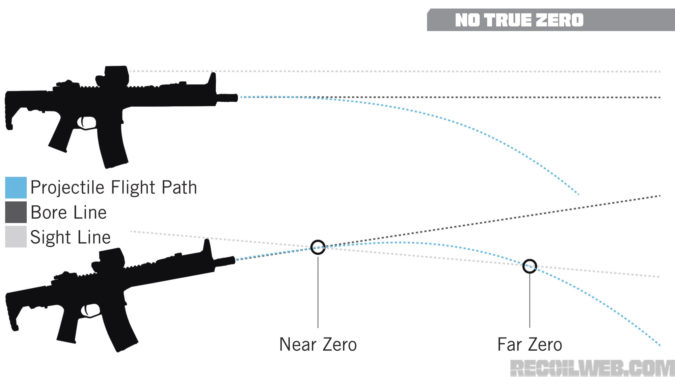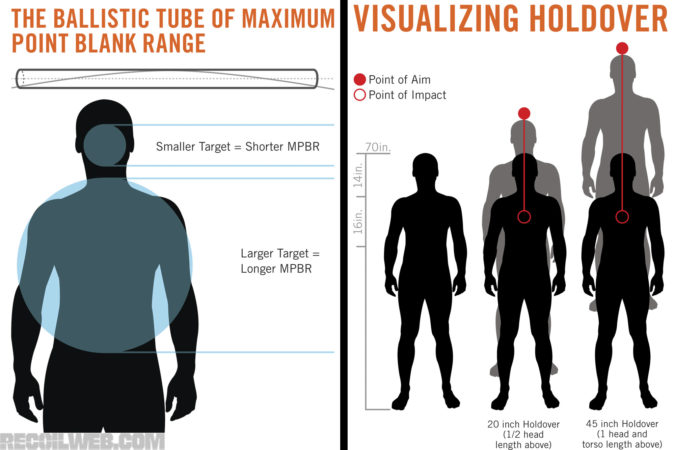No True Zero: Don’t Be a Basic Bitch–Make Your Zero Personal
At RECOIL, we review every product fairly and without bias. Making a purchase through one of our links may earn us a small commission, and helps support independent gun reviews. Read our affiliate policy.
Find out more about how we test products.
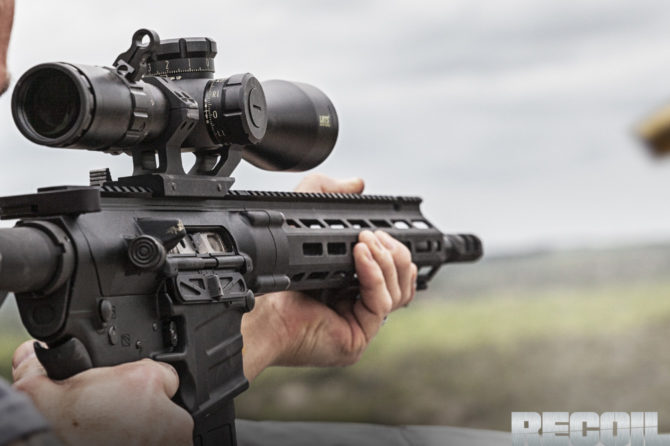
Story and Photos by Candice Horner & Dave Merrill
Ask someone what the best zero is, and you’ll get a response based on personal preference, prior training, and maybe individual needs. If you’re in the military or a law enforcement agency, the distance you zero may well be dictated by an official government publication or crusty old training officer. Most of us aren’t so limited by these restrictions, so why do we revert back to standards that don’t apply?
The U.S. Military has hundreds of thousands of both rifles and people, usually all using similarly spec’d ammunition. They can get away with generalized zeros. And it’s beneficial for them to keep firearms training standardized. But if you don’t have to be basic, you shouldn’t be.
In the simplest terms, a zero is the adjusting of the sights/optic so your point of aim matches your point of impact at a specific distance. This convergence is the intersection between your line of sight and bullet trajectory. Bullets aren’t laser beams like in the movies, and are subject to gravity. If your bore and sight lines were both perfectly parallel, their paths would never cross, and thus no zero could be obtained.
Many prevailing zeros have two convergence points that intersect the line of sight, giving you both a near zero and a far zero. Commonly, these are written as “50/200” or “25/300,” though they virtually never actually print on targets exactly in that manner in the real world. This type of zero is a shortcut solution that doesn’t maximize your rifle’s capabilities.
For most types of shooting, we should strive to have the longest Maximum Point Blank Range (MPBR) possible. In popular culture “point blank” means a shot from an especially close distance; throw maximum into the term and it means the farthest you can shoot and hit your target without having to adjust your sights or hold. You can successfully think of your MPBR as a ballistic tube of Point-Click-Kill.
THE STARTING POINT
Your zeroing distance should be task-oriented. To determine the best zero, answer the following questions:
▻What is your intended target?
▻How far do you plan to shoot?
▻What optic, if any, is on your rifle?
In addition to several variables that go into rifle shooting, your answers to those questions can affect what zero you should actually be using.
The size of the intended target and your anticipated range of engagement determine your required precision standard. If you want to shoot the literal broadside of a barn at 10 feet — your zero doesn’t matter at all. If you want the ability to make a head shot at 425 yards or snag a successful hit on a partially obscured target closer in, having a solid zero and knowing your dope matters. So. Much. More. It shouldn’t come as a shock to anyone that most things don’t just stand there and let you shoot at them.
The larger the intended target, the more leeway you have in your MPBR. If you’re a soldier on the streets of Afghanistan, a required 400-yard hit is infinitely more likely than if you’re a cop on the beat. If you’re a hunter, your MPBR has to measure within the kill zone of the animal. Ultimately, what you’re trying to figure out is how far you can shoot your rifle and make a hit while still maintaining the same point of aim.
You can get the most out of your weapon setup by running a zero that makes sense for your optic. A red-dot sight with no magnification has several benefits, but drawbacks occur when shooting at further distances. Depending on what zero you use with a red-dot, you could be holding a lot of space between the dot and the top of your target. Red-dot optics aren’t used for precision long-range shooting, so running an MPBR zero is beneficial.
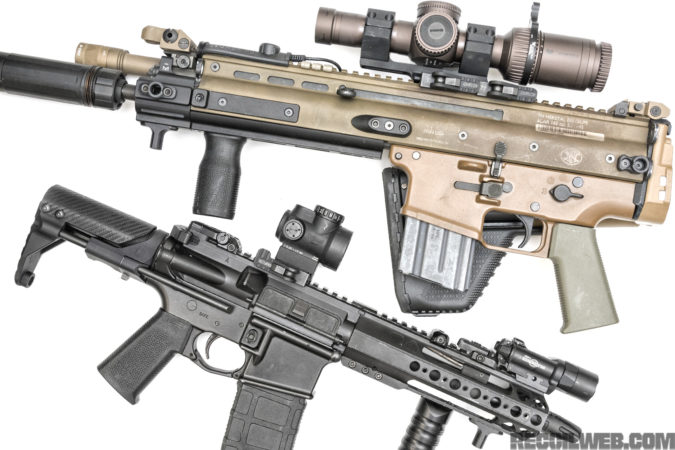
[Same caliber–different rifles, roles, optics, and zeros]
For precision shooting, a 100-yard zero is hard to beat. Having the rifle zeroed at 100 and dialing or using the MOA or MRAD holdovers is precise and predictable. With a 100-yard zero, there isn’t another point of convergence. This is beneficial for long-range shooting because the shooter doesn’t have to problem solve whether or not to hold under or over. The correction for every shot is going to require the shooter to either dial up or hold over.
These days, most scopes have more than enough of elevation adjustment. But you may run into a few scopes that either don’t have elevation turrets intended to be adjusted on the fly, or they may not have enough clicks, or you may not have enough time to dial. Once again, an MPBR zero is ideal. Maximum MPBR gets the most out of your rifle from your position to the target and onward.
Once you surpass the reach of your MPBR, it’s imperative to know your data at every distance. With a red-dot, this means knowing your holdover, and with a magnified optic, either the same or how much to dial.
The capabilities of your rifle setup are as unique as a fingerprint. No two rifles are exactly the same, and they never will be thanks to small variances during the build process, and the fact that every bullet that goes down the barrel permanently changes the rifle. This is why slapping a 50/200-yard zero on it isn’t good enough. So how do we figure it out?
BALLISTIC CALCULATORS — THE CRYSTAL BALL OF LONGRANGE MATH
Using a ballistic calculator to determine the best zero for your weapon system is like having answers to the test. We’re big fans of ballistic engines; no longer do we have to rely on guesswork from trajectory charts online nor old military manuals. Instead, we can tailor a zero to what we want the rifle to do.
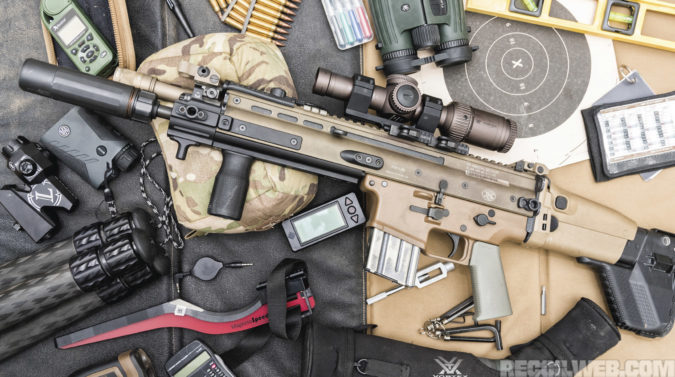
[Everything you need to zero–and a bunch of shit you don't]
Thirty years ago the idea of using a ballistic calculator to determine your best zero was probably a nonstarter for most; it involved a lot of books, specialized equipment, and maybe a protractor or graphing calculator. Ballistics was a mystery, relegated to the most nerdy of long-range shooters. This is no longer the case, and if you have an Internet connection you have free access to some of the best ballistic calculators in the world. Right in your pocket at this moment is likely a computer more powerful than any used by the highest-end university a decade ago. By all means look at cute cat photos and porn with it, but utilize that processor for some calculations too.
If you open up a ballistic calculator, you’ll find several important variables at play — and they all affect where your projectile ends up downrange. Since any minor element or deviation exponentially expands with range, the farther you shoot and the tighter the precision standard, the more each of these components matter.
Stuck at a range that only allows you to shoot 25 yards? Use a calculator to show your offset. At a long range and unsure of your hold? Use a calculator to give it to you. Ballistic calculators aren’t just for simple holdovers either; with most of them you can save individual data from a given gun and ammunition combination for easy access later. Some apps like Strelok Pro have options where you can display the same reticle in your scope on the screen, and literally show you where to hold to make your hit. Many range finders and weather meters will interface with your standalone or in-phone ballistic app to provide you with the best and most up-to-date information.
You can’t rely on the listed velocity on the side of the ammo box if you want your calculations to be anywhere close to reality. Invariably those readings were taken at ideal scenarios — perfect weather, longer barrels, etc. The velocity of a given load is incredibly subject to nuances of your individual rifle. Not only is barrel length a component, but also the cut of the chamber, and even minute differences in barrels on otherwise identical guns. The best way to determine the actual muzzle velocity is to use a good chronograph such as a Magneto Speed or LabRadar. If you don’t have a chronograph or a friend with one, the next best thing would be to find someone who has independently tested the rounds in a similar setup to what you’re using. Imperfect for sure, but better than going by the box.
FINDING YOUR MPBR
If you want to be able to hold center of your target and hit, use technology to figure out what your zero should be. Here’s an example we worked up:
We used the Shooter phone app by Kennedy Development Group LLC. We input all the data for our rifle, ammo, and scope combination. We determined the size of the target we planned to shoot (10 inches). From there, nothing changed except the zeroing distance until finding the MPBR.
Since our intended target is 10 inches round, if we held dead center, we would have a 5-inch radius all the way around our circular target. To relate this to the drop of the bullet, we can only have plus or minus 5 inches of drop in our data if we want to make a hit without adjustment.
We tried the standard 100-, 200-, and 300-yard zeros. The data showed our bullet’s path would stay within our target size:
▻Just over 225 yards with a 100- yard zero
▻Out to 274 yards with a 200-yard zero
▻At a mere 126 yards with a 300-yard zero the trajectory is out of our allowed radius
After running the data for the standard zeroing distances, we adjusted the zero distance until the highest point of the bullet’s path was at 5 inches. Doing this allowed us to use the projectile’s trajectory to its maximum capability, as related to the size of our intended target. With the very specific 292-yard zero for this rifle/ammo combo, our MPBR is around 340 yards. We should be able to hold center on a 10-inch target, out to 340 yards — and hit.
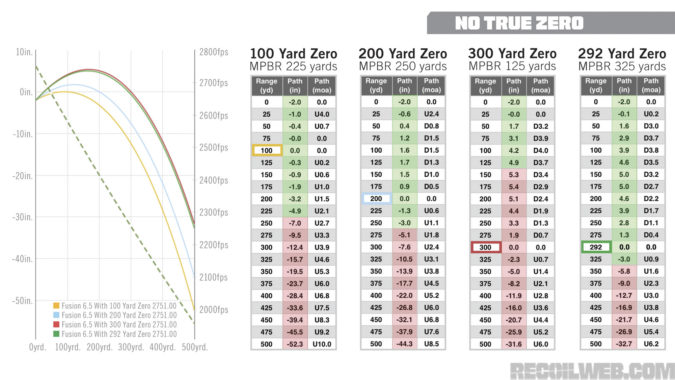
[This example was gathered with a 6.5 Creedmoor using one specific ammunition. Your rifle/ammo combination will be different, so treat it as such.]
YOUR ZERO IS CONSTANTLY CHANGING
We’re not even talking about dropping your rifle. If you zero at sea level in the North Carolina summer, and head over to the peaks of Colorado in the winter, your zero will change. Atmospheric pressure, temperature, elevation, and more will change your point of impact.
There’s an EOTech joke in here, and we’ll address it because we know you’re thinking it: It doesn’t matter what optic you use, if you have a large temperature change your zero absolutely will shift. Know how to zero your rifle and check your zero before taking any important shots.
THAT BDC DOESN’T MEAN WHAT YOU THINK IT MEANS
Just as with a generalized zero, the military can get away with a Bullet Drop Compensator (BDC). A BDC has lines in the reticle itself for elevation holds at given distances for a particular caliber. Except it’s not. Not unless you’re using an identical ammo/rifle combination and are in the same exact environmental conditions the BDC was designed for and tested in.
You can find a good example of a BDC in this very issue — head on over to check out the U.S. Optics SR-85 with Plumb Reticle. Also note that it’s setup for (1) caliber, in (1) given barrel twist with (1) kind of ammunition. A designated marksman in the military can get away with that — you can and should do better.
Several optics manufactures have been marketing BDC reticles to the general public as a solution to engage targets quicker without having to remember your Mil or MOA holds. There are also caliber-dedicated scope turrets to ease the thought process of longrange shooting. But, just as we already mentioned, your zero changes with your environment — and your gun and ammunition combination isn’t the same as the manufacturer.
Don’t rely on these shortcuts when your shots matter.
If you’re going to an area with a different density altitude, first confirm your zero and then either use a ballistic engine that will update the environmental conditions or true your rifle data for every distance you plan to shoot.
But all isn’t lost, once you accept that the stadia lines of the BDC are just lines, you can use them as points of reference. For example, if your hold for 400 yards isn’t exactly center, but instead the bottom of a 10-inch plate, you know that’s your hold.
If your accuracy standard is no greater than minute-of-deer at 80 yards, that random BDC made for a 7.62N on your .30-30 will probably work.
6/7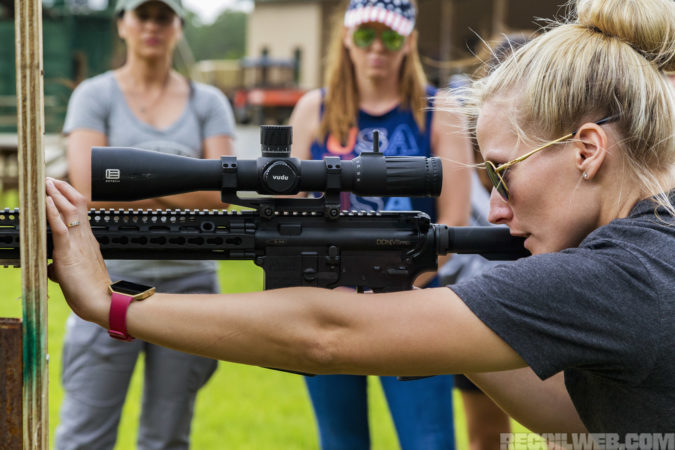
LOOSE ROUNDS
It should be said that regardless of what ballistic engine you use, you’re going to want to confirm those holds are correct by actually shooting rounds down range. Nothing will give you more confidence in your data than making a successful hit.
Initially we thought we would name this piece “Rethinking the Zero,” but it wasn’t accurate — in reality we’re asking you to actually think about how and why you zero in the first place. With numerous ballistic engines and boatloads of data at your fingertips, there’s little excuse not to spend a modicum of time and consideration on your zero.
If you’re the type that thinks a rough zero is good enough and turning dollars into noise is all you want — you do you. But if you want to maximize the capabilities of your unique rifle, optic, and ammunition setup use the tools at your disposal.
Why you can trust RECOIL
Since our founding in 2012, RECOIL remains the premier firearms lifestyle publication for the modern shooting enthusiast. We deliver cutting-edge coverage of guns, gear, accessories and technology. We go beyond basic reviews, providing no B.S. buyer’s guides, hands-on testing and expert analysis on everything from firearms and survival equipment to watches and vehicles.
Our reviewers are the backbone of our operation and come from diverse shooting backgrounds: Former law enforcement, military veterans, competitive shooters, seasoned hunters and plain old firearms enthusiasts. Furthermore, we’re not just gun experts, but dedicated journalists who adhere to the strictest standards of our profession.
At RECOIL, editorial independence is the foundation of everything we publish and the cornerstone of reader trust. Our editors, writers and content creators make all editorial decisions independently, free from outside influence. That boils down to: advertisers don’t dictate our coverage, the outcomes of our reviews or what we recommend in our buyer’s guides. First and always, our commitment is to our audience—ensuring every review and article is accurate, unbiased, and driven by real-world experience.
Whether you’re selecting your next firearm, upgrading your gear, or exploring the latest innovations in the shooting world, RECOIL provides the trusted insights you need to make informed decisions. Learn more about our Editorial Standards and how we review products.
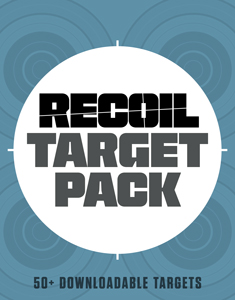
NEXT STEP: Download Your Free Target Pack from RECOIL
For years, RECOIL magazine has treated its readers to a full-size (sometimes full color!) shooting target tucked into each big issue. Now we've compiled over 50 of our most popular targets into this one digital PDF download. From handgun drills to AR-15 practice, these 50+ targets have you covered. Print off as many as you like (ammo not included).Get your pack of 50 Print-at-Home targets when you subscribe to the RECOIL email newsletter. We'll send you weekly updates on guns, gear, industry news, and special offers from leading manufacturers - your guide to the firearms lifestyle.
You want this. Trust Us.

